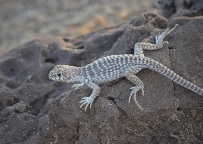Desert Iguana (Dipsosaurus dorsalis)
Description: The desert iguana is a medium-sized lizard which averages 16 inches in total length but can grow to a maximum of 24 inches including the tail. They are pale gray-tan to cream in color with a light brown reticulated pattern on their backs and sides. Down the center of the back is a row of slightly-enlarged, keeled dorsal scales that become slightly larger farther down the back. The reticulated pattern gives way to brown spots near the back legs, turning into stripes along the tail. The tail is usually around 1½ times longer than the body from snout to vent. The belly is pale. During the breeding season, the sides become pinkish in both sexes.
Habitat: Their preferred habitat is largely contained within the range of the creosote bush, mainly dry, sandy desert scrubland below 3,300 feet. They have a significant presence in the Sonoran and Mojave deserts. They can also be found in rocky streambeds up to 3,300 feet. In the southern portion of its range, these lizards lives in areas of arid subtropical scrub and tropical deciduous forest.
Range: The Desert Iguana ranges widely in the southwestern United States, northwestern mainland Mexico, and the Baja Peninsula. Its range encompasses: southern Nevada; extreme southwestern Utah along the Virgin River in the vicinity of Beaver Dam Wash; northwest, central, and southern Arizona; southern California east of the Sierra Nevada and coast mountain ranges; southward into Mexico through northeastern Baja California, all of southern Baja California (excluding most of the Vizcaíno Desert), and western Sonora to northern Sinaloa. This lizard occurs on many islands in the Gulf of California and on Magdalena and Santa Margarita islands along the Pacific coast of Baja California, occurring most densely in sand habitats. The elevational range extends from below sea level in desert sinks (~ 40 m bsl) to about 1,520 m asl
Found in these States:
AZ |
CA |
NV |
UT
Diet: Desert iguanas are primarily herbivorous, eating buds, fruits and leaves of many annual and perennial plants. They are especially attracted to the yellow flowers of the creosote bush. They will eat the foliage of the creosote bush as well. Even though lots of desert iguanas are herbivores there are some subspecies of Desert iguana who have a 54% plant based diet and 44% animal based diet. The most common specie Desert iguanas eat are ants.
Reproduction: Mating takes place in the early spring, often around May-June. It is believed that only one clutch of eggs is laid each year, with each clutch having 3-8 eggs. The hatchlings emerge around September.
Status: Listed as Least Concern in view of its wide distribution, presumed large population, and occurrence within protected areas. There is considerable variation in terms of both threats to the habitat and to the species across its distribution. Thus, particular subpopulations may be of concern especially as the taxonomy is re-evaluated.
»» Kingdom: Animalia - Animals
»» Phylum: Chordata - Chordates
»» Subphylum: Vertebrata - Vertebrates
»» Class: Reptilia - Reptiles
»» Order: Squamata - Lizards
»» Family: Igunaidae - Iguanas
»» Genus: Dipsosaurus
»» Species: Dipsosaurus dorsalis - Desert Iguana
»» Subspecies:
Dipsosaurus dorsalis dorsalis - Northern Desert Iguana
This article uses material from the Wikipedia article "Desert Iguana", which is released under the Creative Commons Attribution-Share-Alike License 3.0. Content may have been omitted from the original, but no content has been changed or extended.
|







